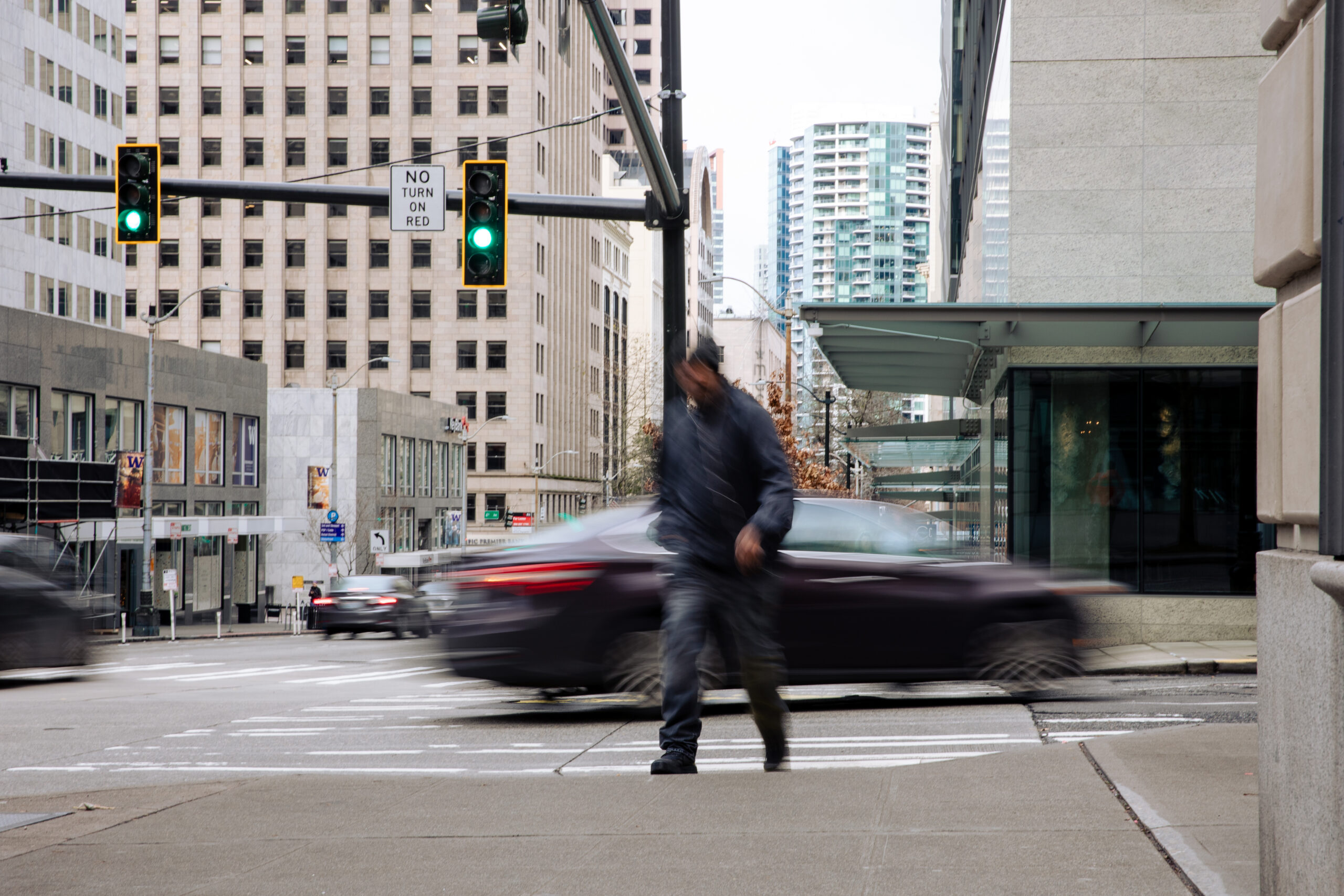
The Alarming Rise in Road Fatalities: Why The Current Approach to Road Safety Isn’t Working
Author: Craig Milligan, Ph.D., P.Eng., RSP2I
Road fatalities and injuries are a growing crisis. After decades of decline, the number of deaths on our roads has plateaued and, alarmingly, started to rise again. This concerning trend is particularly pronounced among vulnerable road users like pedestrians and cyclists, even as we invest more effort and money into road safety initiatives*. It begs the question: if we’re spending more, why aren’t we seeing better results?
The unfortunate truth is that current methods often lack the crucial, real-time insights needed to truly impact safety. This is where a new era of technology emerges. Miovision Continuous Safety is designed to bridge this gap, transforming raw traffic data into actionable, life-saving decisions that directly support ambitious Vision Zero goals.
Every year, 42,0001 people die in road traffic crashes across the US and Canada. This represents an immense and tragic toll on society, and for every fatality, there are many more individuals who suffer severe, life-altering, and debilitating injuries. State Departments of Transportation, cities, and counties are increasingly tasked to tackle this problem, yet they grapple with understanding why current approaches are falling short.
Two Key Reasons Current Approaches Are Failing
There are two primary reasons why traditional approaches to road safety are not yielding the desired outcomes:
- Being too reactive: Historically, the strategy has been to fix unsafe locations after serious crashes have occurred. This “wait for a tragedy” approach means always playing catch-up, rather than proactively preventing incidents.
- Being too slow: The cycles between implementing a road safety change and determining its effectiveness—whether it helped, made things worse, or required adjustment—have been exceptionally long and slow. This is largely due to the reliance on crash data, which requires years to accumulate enough statistically significant information.
As a result, instead of taking multiple, iterative shots at improving safety at every intersection, measuring the response, and fine-tuning our efforts, our work is often limited to one-time, project-based initiatives. This “one-and-done” approach, often based on a single snapshot of crash or near-miss data, is simply too resource-intensive to revisit frequently. Given the inherent complexity of road safety, it’s unrealistic to expect a single intervention to achieve “Vision Zero” – a goal of eliminating all traffic fatalities and severe injuries. While one change might offer an improvement, it’s unlikely to get us all the way there.
The Imperative Need for Miovision Continuous Safety Monitoring
This is precisely why we need proactive safety intelligence. Our intention is to unlock a cycle of incremental innovation, improvement, and immediate feedback. By continuously measuring safety performance, we can iteratively work towards Vision Zero or any desired safety performance target.
Our Continuous Safety Monitoring solution at Miovision is fundamentally based on analyzing near misses, 24/7/365.
What is a Near Miss?
A near miss occurs when two road users narrowly avoid a collision. Researchers also refer to these as “surrogate measures of safety.” These events are meticulously measured using computer vision technology: a camera mounted above the road, connected to a computer and a control cabinet. Our AI analyzes the speed, location, direction, and classification of all road users within the intersection.
What truly sets Miovision’s approach apart is the use of a kinetic energy risk model to define and classify near misses. This model not only identifies whether an event is a near miss but also ranks its severity into critical, high, medium, and low-risk categories. The model considers factors such as road user speed, proximity, angle of interaction, vulnerability of road users, and the order of interaction.
When near-miss data is categorized with these factors, our research partners have achieved an astounding 94% accuracy2 in predicting injury collisions over a long period, using the kinetic energy risk model within Scout Plus for safety studies.
The predictive accuracy of our kinetic energy risk model for near misses is truly unparalleled in the field of road safety. This is crucial because while computer vision is becoming more widespread, enabling others to claim they measure near misses, Miovision excels at identifying the near misses that truly matter – the ones that reliably predict future crashes. There are many near misses that lack the potential to cause injury crashes. Our unique ability to sort and distinguish them using our kinetic energy risk model is fundamental to making real progress on safety.
See Continuous Safety Monitoring in action.
To genuinely improve road safety, it must be viewed as an ongoing operational concern. We empower cities with:
- Proactive Safety Monitoring: Near misses offer a superior alternative to historical crash data, providing predictive insights into where the next crashes are likely to occur before they happen.
- Data-Driven Risk Management: Cities can move beyond anecdotal evidence and public complaints. With continuous, granular safety data, they can understand the root causes of problems and immediately see the impact of their interventions. If a safety improvement is made and a public complaint arises, the data can objectively demonstrate its effectiveness, allowing for the preservation and propagation of successful treatments.
- Equity in Road Safety: Our user-based analysis allows transportation agencies to target specific user groups, ensuring that safety improvements are equitable and address the needs of all road users.
- Acceleration of Road Safety Improvements: Deploying our system to multiple intersections and receiving over-the-air updates is significantly faster and easier than relying on traditional crash data collection methods.
Bellingham, Washington: A Case Study in Continuous Improvement
Let’s look at a real-world example from Bellingham, Washington. After the bike lanes were installed and initial safety improvements were addressed, cyclists were surveyed to get their initial feedback on safety. The results were telling: even after the initial safety improvements, 337 cyclists still felt “definitely unsafe” and 160 felt “somewhat unsafe.” This highlights a critical point: a single safety project, even if beneficial, often doesn’t “finish the job” or achieve Vision Zero.
Following this, Continuous Safety Monitoring was activated for ongoing assessment of the bike lanes’ safety
The Continuous Safety Monitoring data corroborated these feelings, revealing a significant number of near misses, particularly “westbound right hooks.” This demonstrates how continuous monitoring helped them pinpoint remaining issues, guiding further, targeted improvements beyond the initial project.
Read the case study to learn more about the City of Bellingham’s experience.
Shifting to a Continuous, Iterative Approach
What we are unlocking with Continuous Safety Monitoring is fundamentally different from the traditional approach to road safety. The old model—getting a snapshot of data, implementing one intervention, and then leaving it alone—is what has led us to the stagnation of 42,000 deaths per year. Despite SS4A grants, widespread adoption of Vision Zero, and decades of road safety initiatives, the needle isn’t moving.
We are offering the ability to advance Vision Zero goals for the long term by shifting to a continuous, iterative, short-cycle management approach, entirely driven by data. This provides the crucial feedback loop needed to fine-tune road safety at every intersection.
Furthermore, our solution is part of a comprehensive platform. This means clients can seamlessly move from near-miss analysis to data on red-light running, traffic signal operational performance, and even identify underlying root causes where various performance measures might be influenced by similar factors.
This isn’t just a product. We’re really offering a proven scalable safety solution that cities can trust to help futureproof their Vision Zero strategies. By embracing proactive road safety solutions, cities can move beyond reactivity and truly dial in road safety for a future where fatalities and serious injuries are a thing of the past.
Ready to transform your city’s road safety? Schedule a Free Consultation with a Miovision Expert.
*UN Decade of Action, SAFETEA-LU, MAP-21, $5B SS4A
1 NHTSA Press Release 2022
2 Incorporating Speed in a Traffic Conflict Severity Index to Estimate Left Turn Opposed Crashes at Signalized Intersections



